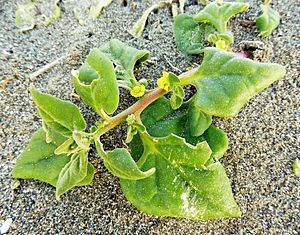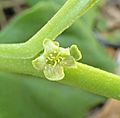New Zealand spinach facts for kids
Quick facts for kids New Zealand spinach |
|
|---|---|
 |
|
| Tetragonia tetragonioides, growing in sand in its native habitat in Japan | |
| Scientific classification | |
| Genus: |
Tetragonia
|
| Species: |
tetragonioides
|
| Synonyms | |
|
Tetragonia expansa |
|
| Nutritional value per 100 g (3.5 oz) | |
|---|---|
| Energy | 51 kJ (12 kcal) |
|
2.13 g
|
|
| Sugars | 0.25 g |
| Dietary fiber | 1.4 g |
|
0.17 g
|
|
|
Protein
|
1.3 g
|
| Vitamins | Quantity
%DV†
|
| Vitamin A | 3622 IU |
| Thiamine (B1) |
3%
0.03 mg |
| Riboflavin (B2) |
9%
0.107 mg |
| Niacin (B3) |
2%
0.39 mg |
| Pantothenic acid (B5) |
5%
0.256 mg |
| Vitamin B6 |
18%
0.237 mg |
| Vitamin C |
19%
16 mg |
| Vitamin E |
8%
1.23 mg |
| Vitamin K |
278%
292 μg |
| Minerals | Quantity
%DV†
|
| Calcium |
5%
48 mg |
| Iron |
5%
0.66 mg |
| Magnesium |
9%
32 mg |
| Manganese |
25%
0.526 mg |
| Phosphorus |
3%
22 mg |
| Potassium |
3%
102 mg |
| Sodium |
7%
107 mg |
| Zinc |
3%
0.31 mg |
| Other constituents | Quantity |
| Water | 94.8 g |
|
Link to USDA Database entry
|
|
| †Percentages estimated using US recommendations for adults. | |
New Zealand spinach is a special plant often grown for its tasty leaves. It's also known as Warrigal greens or Cook's cabbage. This plant is part of the fig-marigold family.
You can find New Zealand spinach growing naturally in eastern Asia, Australia, and New Zealand. It has also spread to many other parts of the world, including Africa, Europe, and North and South America. This plant loves sandy beaches and cliffs. It can even grow well in salty soil!
Contents
What Does New Zealand Spinach Look Like?
This plant usually grows along the ground, forming a thick green carpet. It can also climb over other plants or hang down. When it's young, it might grow straight up.
Leaves and Flowers
The leaves are bright green and shaped like a triangle, about 3 to 15 centimeters long. They are thick and covered with tiny bumps that look like water drops. The plant's flowers are yellow. Its fruit is a small, hard pod with little horn-like bumps on it.
How Was New Zealand Spinach Named?
A scientist named Peter Pallas first described this plant in 1781. Later, another scientist, Otto Kuntze, gave it its current scientific name, Tetragonia tetragonioides, in 1891.
Common Names for the Plant
Because this plant grows in many places, it has many different names! Besides New Zealand spinach, people call it Botany Bay spinach or sea spinach. In the Māori language, it's called kōkihi. Its Australian names, Warrigal Greens and Warrigal Cabbage, come from the word warrigal, which means wild or not farmed.
Growing New Zealand Spinach
People grow New Zealand spinach for its leaves, which are good to eat. It can also be used as a pretty ground cover in gardens. This plant can grow for one year (annual) or many years (perennial).
Cooking with New Zealand Spinach
New Zealand spinach tastes and feels a lot like regular spinach. You can cook it in similar ways. However, like regular spinach, it has natural chemicals called oxalates. To remove most of these, you should quickly dip the leaves in hot water for one minute. Then, rinse them in cold water before you cook them.
This plant grows best in warm weather. It's known as an "heirloom vegetable," meaning it's an old variety passed down through generations. Not many insects, slugs, or snails like to eat it, which is great for gardeners!
Planting Seeds
The seeds of New Zealand spinach are thick and have an unusual shape. You should plant them right after the last frost in spring. Before planting, soak the seeds in cold water for 12 hours, or in warm water for 3 hours.
Plant the seeds about 5 to 10 millimeters deep. Make sure to space them 15 to 30 centimeters apart. The young plants will start to appear in 10 to 20 days. The plant will keep producing fresh greens all summer long. Mature plants will drop their own seeds, so new plants can grow next year.
New Zealand Spinach as Food
Indigenous people didn't use this plant much as a leafy vegetable. However, Captain James Cook first wrote about it. His crew immediately picked, cooked, and pickled the leaves. This helped them fight scurvy, a sickness caused by not enough vitamin C, during their journey on the ship Endeavour.
The plant spread around the world when explorer Joseph Banks took seeds to Kew Gardens in England in the late 1700s. For 200 years, New Zealand spinach was the only vegetable grown from Australia and New Zealand.
Some records show that Māori people might have eaten kōkihi more often. They would boil the older, bitter leaves with the roots of another plant called pōhue to make them taste better. You can eat the tips of New Zealand spinach raw or cooked.
Nutrition Facts
When you boil New Zealand spinach, it's mostly water (95%). It has a little bit of carbohydrates (2%) and protein (1%), but almost no fat. A 100-gram serving only has about 12 calories.
This spinach is super rich in vitamin K, giving you almost three times your daily need! It also has good amounts of vitamin B6, vitamin C, and manganese.
Gallery
See also
 In Spanish: Espinaca de Nueva Zelanda para niños
In Spanish: Espinaca de Nueva Zelanda para niños



